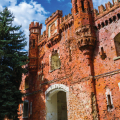FORTRESS OF BREST (КРЕПОСТЬ БРЕСТСКАЯ)
Fortress built in 1842 to symbolize courage, endurance and sacrifice during the Second World War.
It is not only the main attraction of Brest, but also a monument not to be missed during a trip to Belarus. Built in 1842, the Brest fortress is the symbol of the courage, endurance of the Belarusian people and sacrifices made during World War II. Located on the Polish border, you can reach the beautiful Kholmski gate. After the First World War, following the annexation of Brest to Poland from 1921 to 1939, the fortress guesclin a detachment of the Polish army. The distribution of Poland between Germany and the USSR as well as the annexation of the Brest region to Soviet Belarus makes Brest a border City. In the fortress, the troops of the red army are now concentrated. When on 22 June 1941, Germany attacked the USSR, the city of Brest was destroyed in a few days. Nevertheless, Soviet troops, besieged in the fortress, do not surrender and engage in defence to the heroic, desperate and tragic faith of the city. Several sentences written on the walls of the bunkers, such as «I am dying, but I will not go. Farewell, dear homeland, bears witness to the incomparable courage of soldiers. By the end of July, German soldiers were capitulate. On May 8, 1965, the fortress acquired the status of a hero. On September 25, 1971, the commemorative complex was opened there. Today, this impressive complex revives the tragic of the time. The remnants of the ancient fortress have been set up in the style of socialist realism representing a bloated image of war. The entrance into the fortress is a giant star carved in stone. The corridor that crosses this star is in black granite, which contrasts greatly with the red bricks of the ruins of the bunkers we collect from the entrance. A recording of the time reproduced the voice of Yuri Levitan, speaker at Central Soviet Radio, who announced the beginning of the war, followed by the noises of the canonnades and the bombardment. One of the most surprising monuments is La Thirst, which refers to the catastrophic lack of water during the defense of the fortress. Located on the left bank of the river Moukhavets, this sculpture represents a soldier looking for water that slides to the river with his helmet in his hand. Later, you can find the main sculpture of the complex, Le Courage, an imposing concrete monolith in which the face of a combatant is cut. Behind sculpture, engravings tell stories of war. A 100 m obelisk shaped by bayonet dominates the central square of the fortress. Besides, burns the perpetual fire. The two-storey buildings in red brick around the square were the barracks where the soldiers lived. Today there are souvenir stores (normally open from 10 a. m. to 18 p. m.) and galleries where local painters are exposed. In the eastern part of the complex you can see the church of St. Nicholas, protector of the garrison soldiers. On the right, you can see the remains of the White palace, built in the th century for the Officers Assembly. On 3 March 1918, the Central Empires and the Russian Soviet Republic signed the Brest-Brest Treaty. A little further afield is the Defence Museum of the Brest Fortress (open daily from 9 am to 18 pm, 2,50 BYN).
Did you know? This review was written by our professional authors.
Book the Best Activities with Get Your Guide
Members' reviews on FORTRESS OF BREST (КРЕПОСТЬ БРЕСТСКАЯ)
The ratings and reviews below reflect the subjective opinions of members and not the opinion of The Little Witty.

Fine collection of dull local landscapes and portraits of personalities as much austere.